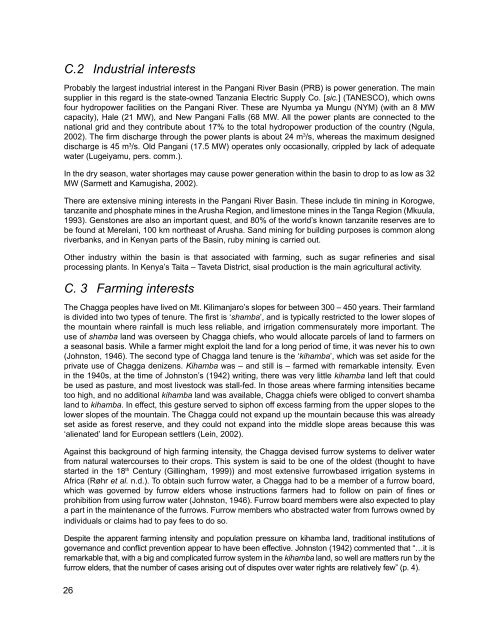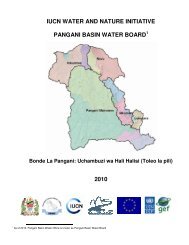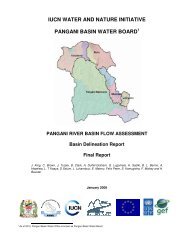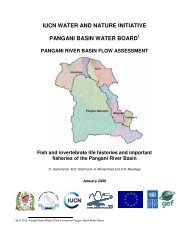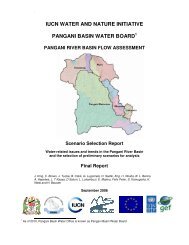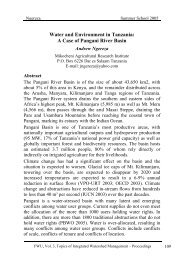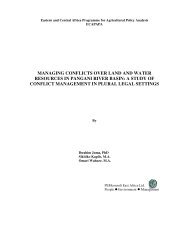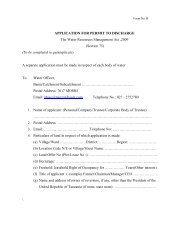PANGANI BASIN WATER BOARD
PANGANI BASIN WATER BOARD
PANGANI BASIN WATER BOARD
You also want an ePaper? Increase the reach of your titles
YUMPU automatically turns print PDFs into web optimized ePapers that Google loves.
C.2 Industrial interests<br />
Probably the largest industrial interest in the Pangani River Basin (PRB) is power generation. The main<br />
supplier in this regard is the state-owned Tanzania Electric Supply Co. [sic.] (TANESCO), which owns<br />
four hydropower facilities on the Pangani River. These are Nyumba ya Mungu (NYM) (with an 8 MW<br />
capacity), Hale (21 MW), and New Pangani Falls (68 MW. All the power plants are connected to the<br />
national grid and they contribute about 17% to the total hydropower production of the country (Ngula,<br />
2002). The firm discharge through the power plants is about 24 m 3 /s, whereas the maximum designed<br />
discharge is 45 m 3 /s. Old Pangani (17.5 MW) operates only occasionally, crippled by lack of adequate<br />
water (Lugeiyamu, pers. comm.).<br />
In the dry season, water shortages may cause power generation within the basin to drop to as low as 32<br />
MW (Sarmett and Kamugisha, 2002).<br />
There are extensive mining interests in the Pangani River Basin. These include tin mining in Korogwe,<br />
tanzanite and phosphate mines in the Arusha Region, and limestone mines in the Tanga Region (Mkuula,<br />
1993). Genstones are also an important quest, and 80% of the world’s known tanzanite reserves are to<br />
be found at Merelani, 100 km northeast of Arusha. Sand mining for building purposes is common along<br />
riverbanks, and in Kenyan parts of the Basin, ruby mining is carried out.<br />
Other industry within the basin is that associated with farming, such as sugar refineries and sisal<br />
processing plants. In Kenya’s Taita – Taveta District, sisal production is the main agricultural activity.<br />
C. 3 Farming interests<br />
The Chagga peoples have lived on Mt. Kilimanjaro’s slopes for between 300 – 450 years. Their farmland<br />
is divided into two types of tenure. The first is ‘shamba’, and is typically restricted to the lower slopes of<br />
the mountain where rainfall is much less reliable, and irrigation commensurately more important. The<br />
use of shamba land was overseen by Chagga chiefs, who would allocate parcels of land to farmers on<br />
a seasonal basis. While a farmer might exploit the land for a long period of time, it was never his to own<br />
(Johnston, 1946). The second type of Chagga land tenure is the ‘kihamba’, which was set aside for the<br />
private use of Chagga denizens. Kihamba was – and still is – farmed with remarkable intensity. Even<br />
in the 1940s, at the time of Johnston’s (1942) writing, there was very little kihamba land left that could<br />
be used as pasture, and most livestock was stall-fed. In those areas where farming intensities became<br />
too high, and no additional kihamba land was available, Chagga chiefs were obliged to convert shamba<br />
land to kihamba. In effect, this gesture served to siphon off excess farming from the upper slopes to the<br />
lower slopes of the mountain. The Chagga could not expand up the mountain because this was already<br />
set aside as forest reserve, and they could not expand into the middle slope areas because this was<br />
‘alienated’ land for European settlers (Lein, 2002).<br />
Against this background of high farming intensity, the Chagga devised furrow systems to deliver water<br />
from natural watercourses to their crops. This system is said to be one of the oldest (thought to have<br />
started in the 18 th Century (Gillingham, 1999)) and most extensive furrowbased irrigation systems in<br />
Africa (Røhr et al. n.d.). To obtain such furrow water, a Chagga had to be a member of a furrow board,<br />
which was governed by furrow elders whose instructions farmers had to follow on pain of fines or<br />
prohibition from using furrow water (Johnston, 1946). Furrow board members were also expected to play<br />
a part in the maintenance of the furrows. Furrow members who abstracted water from furrows owned by<br />
individuals or claims had to pay fees to do so.<br />
Despite the apparent farming intensity and population pressure on kihamba land, traditional institutions of<br />
governance and conflict prevention appear to have been effective. Johnston (1942) commented that “…it is<br />
remarkable that, with a big and complicated furrow system in the kihamba land, so well are matters run by the<br />
furrow elders, that the number of cases arising out of disputes over water rights are relatively few” (p. 4).<br />
26


